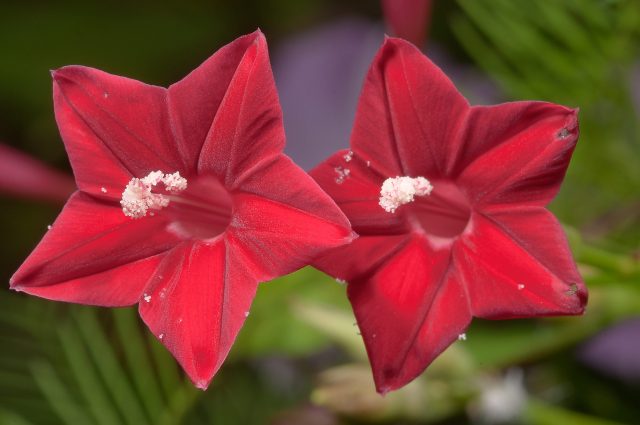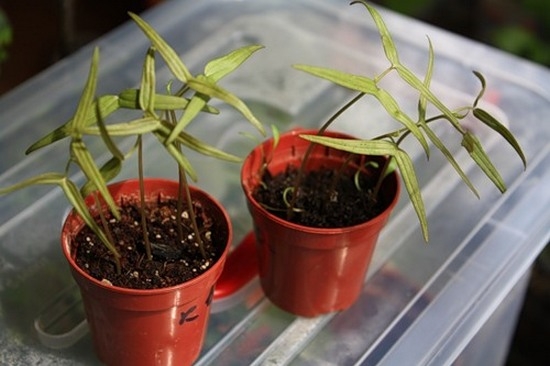Content
It is difficult to find a garden in which representatives of tropical plants do not grow. Most often these are vines that decorate gazebos, fences, and walls of buildings - an excellent option for masking imperfections. The plants are unpretentious, but very decorative. One of these crops is Ipomoea Kvamoklit. Varietal diversity, photos of plants, features of cultivation and care in open ground below.
General description of the species
Ipomoea liana Quamoclite is a tropical plant, considered to be its homeland in Mexico. The beauty is so attractive that landscape designers have long paid attention to it to create various flower arrangements.
The height of the climbing stems during the summer reaches 1.5-4 m, depending on the type and variety. The leaf blades are dissected, pinnate (hence the name), light green in shade.The diameter of the leaves is 5-12 cm, and at the base they are large, closer to the tops of the vine they become smaller.
Morning glory flowers attract with their bright colors in different tones of red. There are white gramophones. The buds have an unusual tube shape. The corolla resembles a star with sharp, slightly bent petals. The diameter of the flowers is up to 3 cm.
It should be borne in mind that solid flowers on a plant bloom only when certain varieties are purchased. In variety mixtures, morning glory with red petals usually prevails.
Morning glory begins to bloom early and pleases with its green leaves and bright gramophones throughout the summer. Flowers bloom with sunrise. In hot weather, the buds fold their petals. Shortly before sunset, the vine opens again.
Ipomoea Kvamoklit pinnate is an unpretentious garden crop that grows on any soil. When choosing a location, it is important to consider that the plant should be planted in well-lit areas, or at least in open shade. But the lack of sun makes the plantings faded; Ipomoea Kvamoklit practically does not form flowers.
In place of the buds, boxes with seeds are formed. At first they are green, turning light brown in autumn. In each box of morning glory Kvamoklit ripens 4 seeds. They can be collected so that you can have your own seed for next year.
Morning glory Kvamoklit develops quickly. Numerous side shoots appear on the main vines. If you do not install supports, the bindweeds will intertwine with each other.The result will be an unkempt mess. Therefore, when planting a garden crop, you need to take this feature into account. The vine looks great on trellises, arches, and threads.
The most striking representatives of the species
Many species and varieties of morning glory pinnate have been bred in the world. But only a few of them grow in Russian gardens:
- Cirrus Quamoclite;
- Ipomoea Red Quamoclite;
- Ipomoea Kvamoklit "Cardinal";
- Lobed Quamoclite;
- Ipomoea "Twinkling Stars" Kvamoklit;
- Slaughter's Quamoclite.
All these varieties are amazingly beautiful, so there are many difficulties when choosing. To figure out what is best to buy for the garden, you need to know a brief description and look at photos of Kvamoklit varieties.
Cirrus quamoclite
This variety of morning glory Kvamoklit is distinguished by carved openwork leaves of dark green shades. The buds of the plant are small and can be red, white, or pink. The vine grows quickly, the main shoot reaches 2.5 m. Ipomoea Kvamoklit begins to bloom late, only in late July - early August, but it pleases with its buds until the first frost.
Morning glory Red quamoclite
Ipomoea Red or fiery Kvamoklit has a special relationship. This cypress vine is distinguished by long, thin vine-like shoots, reaching a height of 3 m. The plant has large, heart-shaped leaves. The diameter of the scarlet tubular buds is approximately 1 cm. Flowering begins in early June and lasts only a month. Then the buds turn black.
Ipomoea quamoclite "Cardinal"
Kvamoklit "Cardinal" Climber is an annual morning glory. It has decorative pinnately dissected leaves. The height of the plant at the end of the growing season is about 2 m. The star-shaped flowers have long tubes. The diameter of the red petals is within 4-5 cm.Flowering begins in July-August and continues until frost.
Lobed quamoclite
Due to the unusual colors of the buds, Quamoclitus is often called the Spanish flag. The Kvamoklit plant stands out with its powerful shoots, distinguished by its red color. The height of morning glory is within 3 m. There are stipules on the heart-shaped leaves. The flowers somewhat resemble a droplet up to 2 cm long.
Once the buds have formed, they are bright red in color. Over time, they fade, becoming first orange, then lemon. One inflorescence contains buds of different colors. Flowering is long lasting.
Morning glory Twinkling stars quamoclite
“Twinkling Stars” is not a variety of morning glory Kvamoklit, but a mixture of different varieties. From the seeds of one packet you can grow flowers with white, red, pink buds. By planting morning glory Kvamoklit, you can get a mixture of colors in one place against the background of green carved leaves, which is clearly visible in the photo below.
Slaughter's Quamoclite
Compared to other varieties, the morning glory hybrid Kvamoklit Slotera is low - only 1.5 m in height. Red tubular inflorescences delight the eye early in the morning, before the sun rises high. It should be noted that the flowers are a rich red hue, like the mantle of a cardinal, which is why Kvamoklit is often called the Cardinal vine.
Reproduction methods
To obtain new plants, you need to purchase Quamoclitus pinnate seeds. You can grow seedlings from seed material or immediately sow seeds in a permanent place when the soil and air warm up.
Planting and caring for morning glory quamoclite
Ipomoea Kvamoklit, according to gardeners, is an unpretentious climbing plant. As already noted, it can be grown through seedlings or sown seeds directly into open ground. You just need to understand that with the second method of propagation, flowering will occur later. But in fact, it is better to use both methods, then the morning glory pinnate Kvamoklit will bloom in the garden continuously until frost.
Seedlings are planted in late May - early June (depending on the climatic characteristics of the region), at the same time the seeds are sown. The distance between plants is 35-50 cm. The thing is that all varieties branch well, so a small distance between the bushes will reduce the growth rate, the plants will not receive sufficient watering and nutrition. As a result, the leaves will begin to turn yellow and the formation of buds will be reduced.
Ipomoea Kvamoklit develops well in well-fertilized soil. Therefore, before preparing the flower beds, be sure to add humus and sand (mineral fertilizers if desired).
Growing quamoclite from seeds at home
The seedling method of growing the cypress vine Kvamoklit pinnate is used by gardeners in those regions where there are special climatic conditions: spring comes late and autumn comes early. Only in this case can you count on full flowering and obtaining seeds.
Planting is planned for the last ten days of March or the first days of April, depending on the time of onset of stable temperature, then the seedlings can be planted in open ground. 1.5 months is enough for the development of the root system and above-ground parts of the plant.
The process of growing seedlings:
- For sowing, you can take containers, cups, peat pots. Many gardeners believe that with single sowing, seedlings develop better and take root faster in open ground, since the root system is not damaged.
- Prepare the soil in advance, which includes turf soil, peat, sand, and humus. You can buy ready-made soil for seedlings in the store. Any soil before sowing seeds is scalded with boiling water. You can add as many potassium permanganate crystals to the water.
- To speed up germination, seeds are soaked in water for 24 hours. The next day, they are dried a little and placed 1 cm deep in the soil. After watering, the planting containers are covered with cellophane and placed in a room with a temperature of 18-20 degrees.
- From time to time the film is lifted and ventilated. If the soil above is dry, water it.
- Shoots appear after 2 weeks. After this, the film is removed and the seedlings are placed in a well-lit window.
Seedlings are planted in open ground after the onset of stable heat. By this time, Kvamoklit grows to 10-20 cm. Seedlings are planted, depending on the variety, at a distance of 35-50 cm.
Growing quamoclite from seeds directly in open ground
In the south, gardeners do not have to grow seedlings, since weather conditions allow them to obtain flowering cypress vines by sowing seeds directly into the ground. It is prepared in advance, preferably in the fall. But you can apply organic fertilizers in the spring, before digging the site.
Seeds are also soaked and sown at the end of April at a distance of 35-50 cm in moist soil. The seeding depth is 2-3 cm. To speed up germination, the area is covered with film.
Caring for quamoclite after planting
Ipomoea Kvamoklit red is an unpretentious plant, planting and caring for it is simple. The plant does not require special attention. Traditional agrotechnical measures:
- watering and loosening;
- weeding and mulching;
- feeding and protection from pests.
The main activity that should not be forgotten is regular watering of the plantings. If there is no precipitation, then Kvamoklit is irrigated after 3 days. 5 liters of warm, settled water is enough for one plant. To improve decorativeness and increase immunity in dry weather, morning glory must be sprayed.
After watering, the soil is loosened and removed weeds. Any fertilizing is combined with watering. To retain moisture and facilitate maintenance, the root zone is mulched with dry grass, peat, and sawdust.
How to feed morning glory quamoclite
If the soil was well fertilized before planting, then organic fertilizers can be used as top dressing. This can be an infusion of green herbs (nettle and plantain), mullein. Complex fertilizers intended for flowers are also suitable.
Disease and pest control
Most often, morning glory Kvamoklit is affected by spider mites. First aid can be carried out without chemicals: spray with cold water after 3 days. If the pest infestation is serious, use chemicals.
To avoid yellowing of the leaves, which indicates low iron content, in addition to fertilizers, you can dig old rusty nails into the soil.
Application in site design
Most often, Kvamoklit is used for landscape gardening. The plant can get along with many garden crops, including campsis, wild grapes, and ivy. Multi-colored tubular morning glory stars combine in an original way with hop leaves and cones.
Plants can be planted under deciduous trees, because morning glory can twine around the trunk. But most often Kvamoklit is planted around gazebos, creating arches or hedges.
Conclusion
Ipomoea Kvamoklit is an amazing plant that can be grown in pots. In this case, gratings and rods will serve as supports.

















